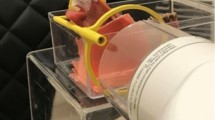Abstract
Objective
To examine the validity of manually defined bony regions of interest from computed tomography (CT) scans.
Materials and methods
Segmentation measurements were performed on the coronal reformatted CT images of the three phalanx bones of the index finger from five cadaveric specimens. Two smoothing algorithms (image-based and Laplacian surface-based) were evaluated to determine their ability to represent accurately the anatomic surface. The resulting surfaces were compared with laser surface scans of the corresponding cadaveric specimen.
Results
The average relative overlap between two tracers was 0.91 for all bones. The overall mean difference between the manual unsmoothed surface and the laser surface scan was 0.20 mm. Both image-based and Laplacian surface-based smoothing were compared; the overall mean difference for image-based smoothing was 0.21 mm and 0.20 mm for Laplacian smoothing.
Conclusions
This study showed that manual segmentation of high-contrast, coronal, reformatted, CT datasets can accurately represent the true surface geometry of bones. Additionally, smoothing techniques did not significantly alter the surface representations. This validation technique should be extended to other bones, image segmentation and spatial filtering techniques.




Similar content being viewed by others
References
Chaney E, Ibbott G. Methods for image segmentation should be standardized and calibrated. Med Phys 2005; 32: 3507–3510.
Gerig G, Jomier M, Chakos M. Valmet: a new validation tool for assessing and improving 3D object segmentation. Proceedings of the 4th International Conference on Medical Image Computing and Computer-Assisted Intervention (MICCAI 2001). Utretcht, Netherlands. Springer; 2001.
Rao M, Stough J, Chi YY, et al. Comparison of human and automatic segmentations of kidneys from CT images. Int J Radiat Oncol Biol Phys 2005; 61: 954–960.
Spinks R, Magnotta VA, Andreasen NC, et al. Manual and automated measurement of the whole thalamus and mediodorsal nucleus using magnetic resonance imaging. Neuroimage 2002; 17: 631–642.
Warfield SK, Zou KH, Wells WM. Validation of image segmentation and expert quality with an expectation-maximization algorithm. in Proceedings of the 5th International Conference on Medical Image and Computing and Computer-Assisted Intervention (MICCAI 2002). Tokyo, Japan. Springer; 2002.
Warfield SK, Zou KH, Wells WM. Simultaneous truth and performance level estimation (STAPLE): an algorithm for the validation of image segmentation. IEEE Trans Med Imaging 2004; 23: 903–921.
Zou KH, Warfield SK, Bharatha A, et al. Statistical validation of image segmentation quality based on a spatial overlap index. Acad Radiol 2004; 11: 178–189.
Zou KH, Wells WM 3rd, Kikinis R, Warfield SK. Three validation metrics for automated probabilistic image segmentation of brain tumours. Stat Med 2004; 23: 1259–1282.
Chiarot CB, Siewerdsen JH, Haycocks T, Moseley DJ, Jaffray DA. An innovative phantom for quantitative and qualitative investigation of advanced x-ray imaging technologies. Phys Med Biol 2005; 50: N287–N297.
Collins DL, Zijdenbos AP, Kollokian V, et al. Design and construction of a realistic digital brain phantom. IEEE Trans Med Imaging 1998; 17: 463–468.
Ward RC, Yambert MW, Toedte RJ, et al. Creating a human phantom for the virtual human program. Stud Health Technol Inform 2000; 70: 368–374.
Eckstein F, Cicuttini F, Raynauld J, Waterton J, Peterfy C. Magnetic resonance imaging (MRI) of articular cartilage in knee osteoarthritis (OA): morphological assessment. Osteoarthritis Cartilage 2006; 14(A): A46–A75.
Ratiu P, Hillen B, Glaser J, Jenkins DP. Visible Human 2.0–the next generation. Stud Health Technol Inform 2003; 94: 275–281.
Spitzer V, Ackerman MJ, Scherzinger AL, Whitlock D. The visible human male: a technical report. J Am Med Inform Assoc 1996; 3: 118–130.
Spitzer VM, Whitlock DG. The Visible Human Dataset: the anatomical platform for human simulation. Anat Rec 1998; 253: 49–57.
Yoo TS, Ackerman MJ, Vannier M. Toward a common validation methodology for segmentation and registration algorithms. in Proceedings of the 3rd International Conference on Medical Image Computing and Computer-Assisted Intervention (MICCAI 2000). Pittsburgh, Pennsylvania. Springer; 2000.
Cohen Z, McCarthy D, Kwak S, et al. Knee cartilage topography, thickness, and contact areas from MRI: in-vitro calibration and in-vivo measurements. Osteoarthritis Cartilage 1999; 7: 95–109.
Neu CP, Crisco JJ, Wolfe SW. In vivo kinematic behavior of the radio-capitate joint during wrist flexion-extension and radio-ulnar deviation. J Biomech 2001; 34: 1429–1438.
Andreasen NC, Cohen G, Harris G, et al. Image processing for the study of brain structure and function: problems and programs. J Neuropsychiatry Clin Neurosci 1992; 04: 125–133.
Magnotta VA, Harris G, Andreasen NC, O’Leary DS, Yuh WTC, Heckle D. Structural MR image processing using the BRAINS2 toolbox. Comput Med Imaging Graph 2002; 26: 251–264.
Donahue TLH, Hull ML, Rashid MM, Jacobs CR. A finite element model of the human knee joint for the study of tibio-femoral contact. J Biomech Eng 2002; 124: 273–280.
PIXform 2001 tutorial. 2001, Roland DG Corporation.
Sharp GC, Lee SW, Wehe DK. Invariant features and the registration of rigid bodies. in Proceedings of the IEEE International Conference on Robotics and Automation 1999. Detroit, Michigan. IEEE; 1999.
Danielsson PE. Euclidean distance mapping. Comput Graph Image Process 1980; 14: 227–248.
Bland JM, Altman, DG. Statistical methods for assessing agreement between two methods of clinical measurement. Lancet 1986; i: 307–310.
Eckstein F, Hudelmaier M, Wirth W, et al. Double echo steady state magnetic resonance imaging of knee articular cartilage at 3 tesla: a pilot study for the Osteoarthritis Initiative. Ann Rheum Dis 2006; 65: 433–441.
Graichen H, Eisenhart-Rothe R, Vogl T, Englmeir F, Eckstein F. Quantitative assessment of cartilage status in osteoarthritis by quantitative magnetic resonance imaging: technical validation for use in analysis of cartilage volume and further morphologic parameters. Arthritis Rheum 2004; 50: 811–816.
Acknowledgments
The authors would like to acknowledge the invaluable assistance of Taften Kuhl. Financial support was provided by National Institute of Biomedical Imaging and Bioengineering/National Institutes Of Health (NIBIB/NIH) awards R21EB001501 and R01EB005973 and a National Science Foundation (NSF) graduate fellowship.
Author information
Authors and Affiliations
Corresponding author
Rights and permissions
About this article
Cite this article
DeVries, N.A., Gassman, E.E., Kallemeyn, N.A. et al. Validation of phalanx bone three-dimensional surface segmentation from computed tomography images using laser scanning. Skeletal Radiol 37, 35–42 (2008). https://doi.org/10.1007/s00256-007-0386-3
Received:
Revised:
Accepted:
Published:
Issue Date:
DOI: https://doi.org/10.1007/s00256-007-0386-3




